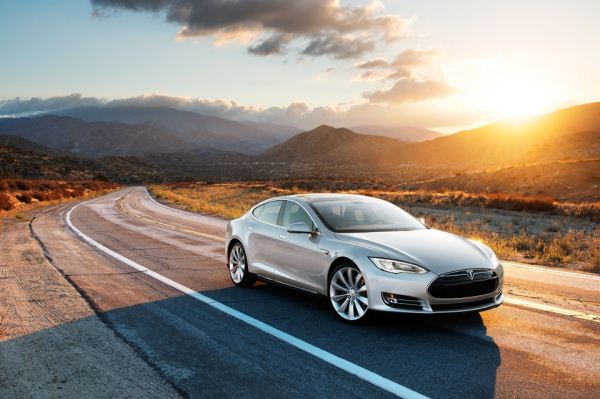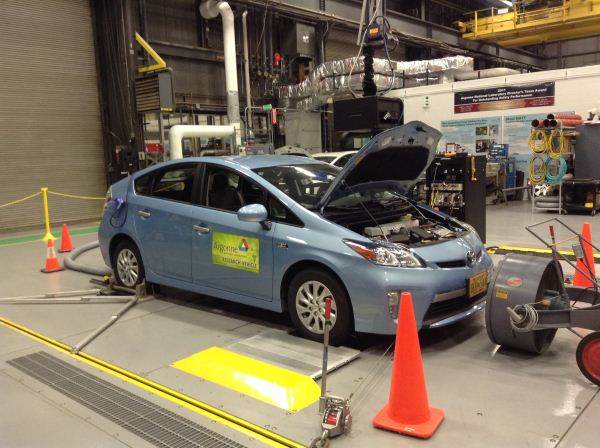The Tesla Model S Controversy: Understanding the Effects of Temperature on Electric Vehicle Efficiency and Range
by Vivek Gowri on February 18, 2013 4:22 PM EST- Posted in
- Auto
- Electric Vehicles
- Tesla Model S
- Nissan Leaf
Thus far, plenty of ink has been spilled regarding the Tesla Model S and the fallout from the New York Times article, and it even showed up in our latest podcast. I feel like my perspective on this topic, as someone who has worked in the EV space as an engineer for the last four years, as well as driving a family owned Nissan Leaf for the last year and a half, is a bit different from our editors who discussed it, as well as most of the others who have written about it.
I’m not particularly interested in getting involved with the back and forth or analyzing what either party said - I feel like the Times reporter didn’t really understand how EVs work, nor how to drive them, and I don’t really agree with Elon Musk’s Matlab data infused response (it felt too vitriolic to get across any point other than Tesla being angry about the article). And just to go back to the point about not understanding how EVs should be driven, you have to tailor your driving style to suit the powertrain in order to get the maximum out of the EV - if you don’t want to, you’re going to be disappointed. Consider it like needing to switch keyboard shortcuts when you move from Windows to OS X - it’s a slight mental recalibration that has to happen for you to use the platform to its fullest. But that’s another story for another time.
What I feel like is getting lost here is actual EV performance in cold weather, or hot weather, or really anything in the way of hard numbers. We all know that battery performance is reduced in more extreme environmental conditions, and that all cars, regardless of powertrain type, consume more energy (fuel or battery) in those extreme climates. Unfortunately, quantifying these general ideas is a bit more difficult. That’s where I come in.
Technology Background
First, a bit of background. I spent the last few months working in Argonne National Laboratory’s Advanced Powertrain Research Facility (APRF). They’re an extremely knowledgeable group of engineers and scientists whose job it is to test advanced technology vehicles in their temperature controlled dynamometer facility, which can sustain temperatures anywhere between -5 F to 100 F. Most of this research is done as a part of the Department of Energy’s Vehicle Technology Program.
Everything from pure electrics to plug-in hybrids, normal hybrids, clean diesels, direct engine turbos, and advanced transmissions (dual-clutch, CVT, etc.) go through the labs with an extended set of instrumentation to collect various speed and consumption metrics. The resulting data sets are truly comprehensive (2 million data cells for 20 minutes on the dynamometer) and allow the researchers to draw conclusions about the various powertrains and their behavior. It’s a pretty impressive setup.
The APRF has released some of the data to the public in something called the Downloadable Dynamometer Database. The D3 pages for the Nissan Leaf includes data from the three different temperatures used in EPA’s 5-Cycle fuel economy test: 20F (with a heater load), 72F (climate control off), and 95F + sun lamps (with an air conditioning load). In all cases involving heating or air conditioning, the climate control system is set to 72F. Using this data, we can take a more in depth look at what the actual penalties of environment are on efficiency and performance, and really see the impact of temperature on energy consumption and range.
Before we start, I should probably explain the terms used in the graphs that follow. UDDS is an urban driving cycle (it stands for Urban Dynamometer Driving Schedule), CS stands for cold start (the first start after the vehicle has been sitting for a number of hours), HS is hot start (any subsequent start after the vehicle has warmed up), HWY is short for HWFET or Highway Fuel Economy Test (also seen as the Highway Fuel Economy Driving Schedule or the EPA’s highway fuel economy cycle), and US06 is a supplemental federal test procedure (SFTP) to provide a more aggressive driving schedule than the relatively tame HWFET cycle. A comparison of the three driving cycles (speed versus time) is shown above.













102 Comments
View All Comments
relztes - Monday, February 18, 2013 - link
How can it possibly be unfair to test the US model in the US? If they took it to Nunavut for a test at -30 F, I'd see your point, but there is nothing extreme about 20 F in at least half of the US.Kerdal - Monday, February 18, 2013 - link
Trust me, they don't have to go as far as Nunavut to test at -30F (-35°C), it was -45°C (-50F) a few days ago over here (QC) hahaMost cars wouldn't start, I wonder what kind of range an EV would get at those temperatures but that's probably why we don't have any over here.
Alexvrb - Monday, February 18, 2013 - link
Bingo. The Nissan Leaf is a POS. It sucks horribly in cold weather (anything below freezing point of water, apparentely). It also uses air cooling for the battery pack, so it suffers quite horribly in hot climates, especially long-term. The Leaf is an all-compromise car. The Model S is leaps and bounds better, though it's got a price tag to show it.The Volt and even more common hybrid designs are a better option at this point, if you don't have the cash for a Tesla Model S.
Alexvrb - Monday, February 18, 2013 - link
Err, and by better option I mean if you are only considering EVs, PHEVs, etc. There are lots of good options depending on how you're driving and what your needs are. For example small diesels or specially tuned small turbo gas motors for highway commutes.IKeelU - Monday, February 18, 2013 - link
Thanks for this article. It's nice to hear an educated response to the controversy.ricardoduarte - Monday, February 18, 2013 - link
Without having much to do with post, i have a few questions since the Vivek is electric car driver.I admit that i know little about EV's and I am a petrolhead, which loves everything about petrol cars, however i always wondered what would be like to compare the fuel expense with a petrol car (I am in uk and both are quite expensive at the moment).
I wonder if you have any other cars (for longer journeys), or this is the household main car?
- How many times do you charge your car per day?
- Have u noticed any big advantage financially to the use of an electric car?
- Do you avoid random driving because of fear of running out of charge, or that you might actually need the car later?
Sorry for the questions, but i always wondered if drivers of electrical car feel restricted because of the battery recharge time, and if the financial advantages are big enough to compensate any anxiety that the presence of batteries might give.
happycamperjack - Monday, February 18, 2013 - link
The fundamental problem of pure EV car is simple, Limited Freedom. Since the introduction of car, it has been the symbol of freedom throughout ages. How many hollywood films have you watched that have cars driving into the sunset? Sure current EV might last you 200 miles or 300 miles and that's plenty for everyone, but that anxiety of running out of juice is always gonna be in the back of your mind. People don't want to wait to charge their car, that directly limited their freedom of movement. If they don't mind that, they probably wouldn't mind public transportation either. So what you end up is a product that's perfect for engineers who can plan ahead and optimize their schedule around it. For anyone else it's a product that's unproven, anxiety inducer, pricey, and just a chore to deal with.Plug in hybrids make a lot more sense. For city driving, the 30+ miles range is enough for most of the people during work days. For vacation or weekend getaways, that's where gasoline comes in. Knowing that you would not have to plan all the "charging" stops well ahead of time, makes life so much easier. Volt is a good start, but it's pretty ugly and feels cheap inside out when you compared to cars in the same price range, that's why it's not selling well. Fisker's reliability problems from multi sourcing parts(reminds me of F35) is scaring away potential buyers. The market is really waiting for a winning design. I really hope Tesla would consider adding at least a small gasoline motor to keep the electric motor running at perhaps 50% capacity when it's out of juice.
IKeelU - Monday, February 18, 2013 - link
The points you make about EVs could become less relevant over time. Namely:- Recharging stations will become more common, making the more limited range of an EV less of an issue, and eventually (hopefully) a non-issue. After all, limited gas stations didn't hamper the adoption of gas-fueled cars a century ago.
- Recharging times will shorten as battery tech improves.
- Battery charges will increase as battery tech improves.
I agree about the hybrids. I rented a For C-Max for a week and mostly did city driving (except for the 30-mile drive to and from the airport), and the top-off before returning to the airport cost me about 8 bucks. I'm pretty much sold on renting hybrids from now on.
happycamperjack - Monday, February 18, 2013 - link
Thanks for the comment. As for now, there are more than 10x the gas stations than charging stations in US, and a lot of them are in california. Not to mention it takes 10 times longer (in charging stations, even longer without it) to charge a EV than a gasoline car. And if everyone's doing it, it's gonna overload the grid and force more "dirty" electricity production to keep it up. I think all this add up to an inconvenient solution for most of the population in US. Like I said, for more well organized people like engineers, this would not be as much of a problem. But why have a problem when you can have none? Our electric technology and the grid is not quite there yet.This situation reminds me a lot of Tablet PC. The concept was good, but technology(capacitive screen and battery) wasn't there to make it good enough to sell to the mass.
melgross - Monday, February 18, 2013 - link
Try 1,000 to 1, or more. But the point is that so far, these EVs, are very range limited, and people expect a $100,000 car to do better. So while these road tests aren't exactly fair, or done well, they do illustrate the point that they come nowhere near a gas fueled vehicle